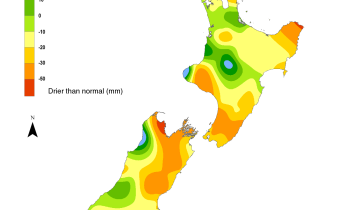A weekly update describing soil moisture patterns across the country to show where dry to extremely dry conditions are occurring or imminent. Regions experiencing significant soil moisture deficits are deemed “hotspots”. Persistent hotspot regions have the potential to develop into drought.
Facts: Soil Moisture
In the North Island, moderate to heavy rainfall amounts of generally 30-70 mm have occurred in most of the northern two-thirds of the island during the past week. In addition, heavy rainfall across Gisborne and northern Hawke’s Bay in recent days has led to over 100 mm there, with isolated amounts greater than 200 mm. Conversely, generally light rainfall of 15 mm or less was observed in the Far North and the lower third of the North Island. This resulted in moderate to large soil moisture increases across much of the upper North Island, although small to moderate decreases occurred in Wairarapa. The driest soils across the North Island, when compared to normal for this time of the year, are found in coastal Wairarapa, while the wettest soils for this time of the year are found across much of the upper North Island.
Currently, no official hotspots are located in the North Island. The New Zealand Drought Index (NZDI) map below shows that no dry conditions are located in the North Island as of 1 November.
In the South Island, generally 25-50 mm of rain fell across the West Coast in the past week, with 10-25 mm occurring in Nelson, Marlborough, and northern Canterbury. However, only meagre amounts of 10 mm or less were observed across much of coastal Canterbury, Otago, and Southland. This resulted in small to moderate soil moisture increases across the upper South Island, while coastal Canterbury and the lower South Island saw small to moderate soil moisture decreases. The driest soils in the South Island compared to normal for this time of year are located in parts of coastal Canterbury, while the wettest soils for this time of the year are found in far northern Canterbury and Marlborough.
Currently, no official hotspots are located in the South Island, although coastal Ashburton District may be approaching hotspot status. The New Zealand Drought Index (NZDI) map below shows that no dry conditions are located in the South Island as of 1 November.
Outlook and Soil Moisture
In the North Island, periods of moderate to even heavy rainfall may continue to affect Gisborne and Hawke’s Bay through Saturday (6 November), while showers and isolated thunderstorms develop elsewhere. Beginning around Monday (8 November), high pressure will result in mostly dry weather across the North Island for several days, with only isolated afternoon showers possible. Weekly rainfall totals could exceed 60-70 mm in Gisborne and Hawke’s Bay, with as much as 30 mm in Wairarapa. 20-40 mm could accumulate in most of the rest of the North Island, although lighter amounts of 15 mm or less are likely from Taranaki south to Wellington City.
The substantial rainfall expected in the eastern North Island this week will result in increased soil moisture levels there, with at least minor increases possible in many other areas. However, minor soil moisture decreases may be observed from Taranaki to Wellington City in the next week. No hotspots are expected to form in the North Island during the next week, with dry areas in Wairarapa likely to see at least minor improvement in the coming days.
In the South Island, many locations will see little if any rainfall over the next several days as high pressure sits overhead. The exception will be far northern areas, where scattered showers will occur through the upcoming weekend. Some showers or light rain may arrive in western areas by around Wednesday (10 November), but eastern areas will remain mostly dry. Weekly rainfall totals may reach 25-50 mm in the West Coast, but only 10-20 mm in the upper and lower South Island. Meanwhile, rainfall totals in Canterbury could be less than 10 mm.
Due to the expected weekly rainfall, most areas will likely see little change to soil moisture levels, or even a minor decrease. However, much of Canterbury could see more significant soil moisture decreases due to a combination of meagre rainfall and unseasonably warm temperatures. This may result in a hotspot developing in coastal central Canterbury during the next week.
Background:
Hotspot Watch: a weekly advisory service for New Zealand media. It provides soil moisture and precipitation measurements around the country to help assess whether extremely dry conditions are imminent.
Soil moisture deficit: the amount of water needed to bring the soil moisture content back to field capacity, which is the maximum amount of water the soil can hold.
Soil moisture anomaly: the difference between the historical normal soil moisture deficit (or surplus) for a given time of year and actual soil moisture deficits.
Definitions: “Extremely” and “severely” dry soils are based on a combination of the current soil moisture status and the difference from normal soil moisture (see soil moisture maps at https://www.niwa.co.nz/climate/nz-drought-monitor/droughtindicatormaps)
Hotspot: A hotspot is declared if soils are "severely drier than normal" which occurs when Soil Moisture Deficit (SMD) is less than -110 mm AND the Soil Moisture Anomaly is less than -20 mm.
Pictured above: Soil Moisture Anomaly Maps, relative to this time of year. The maps show soil moisture anomaly for the past two weeks.
New Zealand Drought Index (NZDI)
As of 1 November, the New Zealand Drought Index (NZDI) map below shows that no dry conditions are located across the country at this time. Please note: some hotspots in the text above may not correspond with the NZDI map. This difference exists because the NZDI uses additional dryness indices, including one which integrates the rainfall deficit over the past 60 days. Changes are therefore slower to appear in the NZDI compared to soil moisture anomaly maps that are instantaneously updated.










